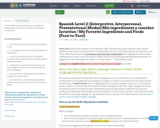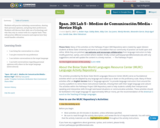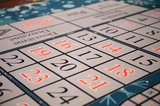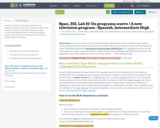
In this activity students will survey one another to determine how much their classmates like/dislike certain foods.
- Subject:
- Arts and Humanities
- Languages
- Material Type:
- Activity/Lab
- Date Added:
- 12/05/2018

In this activity students will survey one another to determine how much their classmates like/dislike certain foods.

In this activity students will survey one another to determine how much their classmates like/dislike certain foods.

In this activity students will survey one another to determine how much their classmates like/dislike certain foods.

Students will practice discussing their preferences, how to defend and support their ideas. Students learn topics through a game of bingo and express how relevant certain ideas are over others.

Students will practice discussing their preferences, how to defend and support their ideas. Students learn topics through a game of bingo and express how relevant certain ideas are over others. Students will use technology to communicate with peers about their preferences on a variety of topics.

Students will practice discussing their preferences, how to defend and support their ideas. Students learn topics through a game of bingo and express how relevant certain ideas are over others. Students will use technology to communicate with peers about their preferences on a variety of topics.

Students will practice initiating conversations, sharing their personal opinions, and giving their preferences. Students will discuss their daily use of technology and who they stay in contact with on a regular basis. They will practice different scenarios and express how they would handle a situation.

Students will practice initiating conversations, sharing their personal opinions, and giving their preferences. Students will discuss their daily use of technology and who they stay in contact with on a regular basis. They will practice different scenarios and express how they would handle a situation.

Students ask each other various questions about their preferences to get to know each other.

Students will discuss their preferences and defend and support their ideas. Students will exchange opinions on a variety of topics through a game of bingo.

Students will discuss their preferences and defend and support their ideas. Students will exchange opinions on a variety of topics through a game of interest bingo.

Students will discuss their preferences and defend and support their ideas. Students will exchange opinions on a variety of topics through a game of bingo. This activity was revised for a high school Heritage Spanish Speakers class. One of the goals with this class is for students to be able to articule and defend their point of view, even when it is abstract. By adding an intercultural compononent to this activity, students will go beyond themselves and explore the perspectives of their classmates.

Students will practice discussing their preferences, how to defend and support their ideas. Students learn topics through a game of bingo and express how relevant certain ideas are over others.

In this activity students will chat about familiar situations and daily activities. Students will chat about their personal preferences, in particular their favorite sports. They will practice how to appropriately plan for others through asking and planning accordingly to their responses.

Students will discuss and give reasons for their preferences and interests. They will practice discussing characters, plots, and elements of programs they already enjoy. Students will also decide appropriate ways to share their ideas in creating a new television program with a small group.

Students will be put into groups to create their own tv show using the vocabulary words provided on the slides.

In this activity, students will figure out the lie from three statements about Boise State and Idaho. Also, they will say two statements that are true and one that is a lie about them with a partner or in a group. The rest of the group will guess the lie in the statements.

Students will engage in conversation about their preferences when given two choices. Students will take turns asking their partners questions.

Students will engage in conversation about their preferences when given two choices. Students will take turns asking their partners questions.

Students will engage in conversation about their preferences when given two choices. Students will take turns asking their partners questions.